The works of the French master Paul Cézanne served as a bridge from the Impressionism of the 19th century to the Cubism of the 20th century. The pinnacle of his career was the series of paintings "Card Players," which continues to set records and captivate art enthusiasts in the 21st century.
Paul Cézanne was born in the south of France in the city of Aix-en-Provence in 1839 into the family of a wealthy lawyer and banker. His father insisted that his son follow in his footsteps, but Paul had other ideas. In search of fame, Paul moved to Paris with his childhood friend Emile Zola but failed to conquer or love the capital. The inheritance after his father's death in 1886 solved Cézanne's financial problems and provided an opportunity to focus on art. Freed from the need to chase commissions, he returned to the province dear to his heart and fully devoted himself to self-realization.
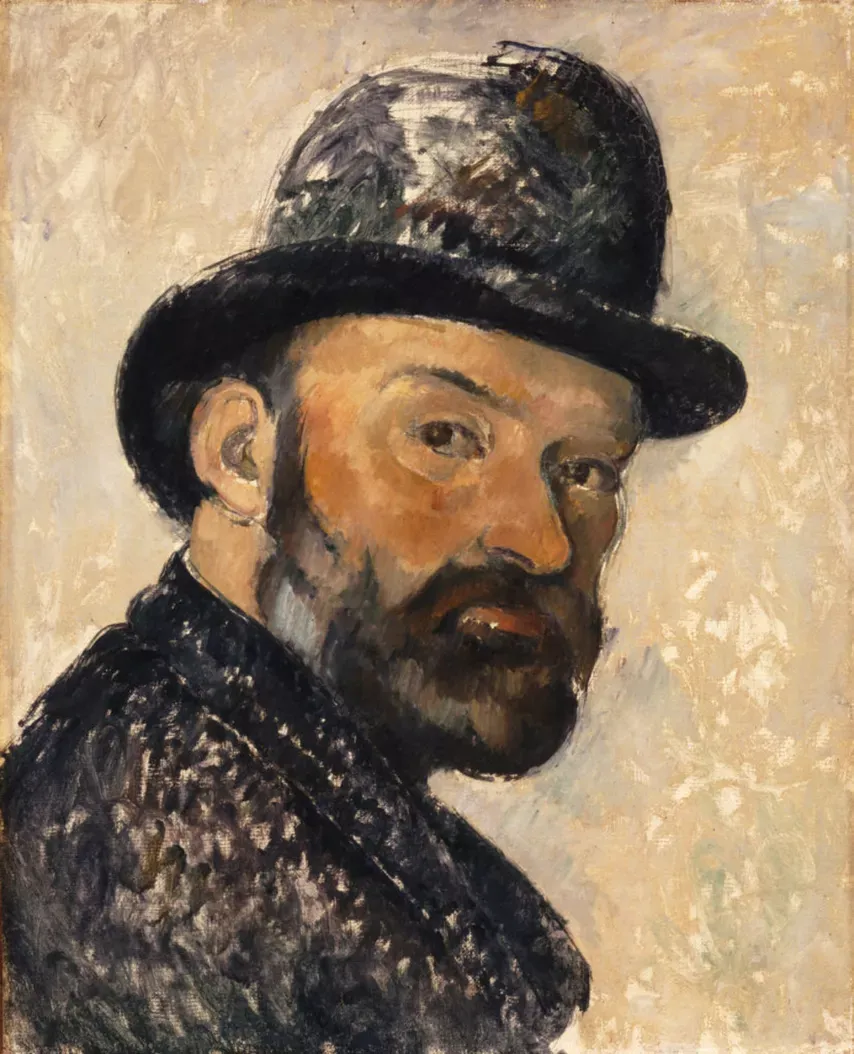
He didn't have a formal artistic education, and his style was shaped by the masters at the Louvre and long reflections on the nature of art. He came to the idea that an artist must first penetrate the essence of the object and then express it through form, color, and composition. The photographic accuracy of reality did not seem like a worthy goal to him.
Cézanne painted "Card Players" between 1890–1895.
Five Unique Oil Paintings in Cézanne's Famous Series
The series consists of five different oil paintings, which became one of the masterpieces of his later period.
The paintings differ in the number of players and the size of the canvas – from 47 x 56.5 cm to 134.6 x 180.3 cm. Four paintings are housed in museums in Europe and America, the fifth was stored in a private collection until recently when it was purchased by the authorities of Qatar for the national museum.
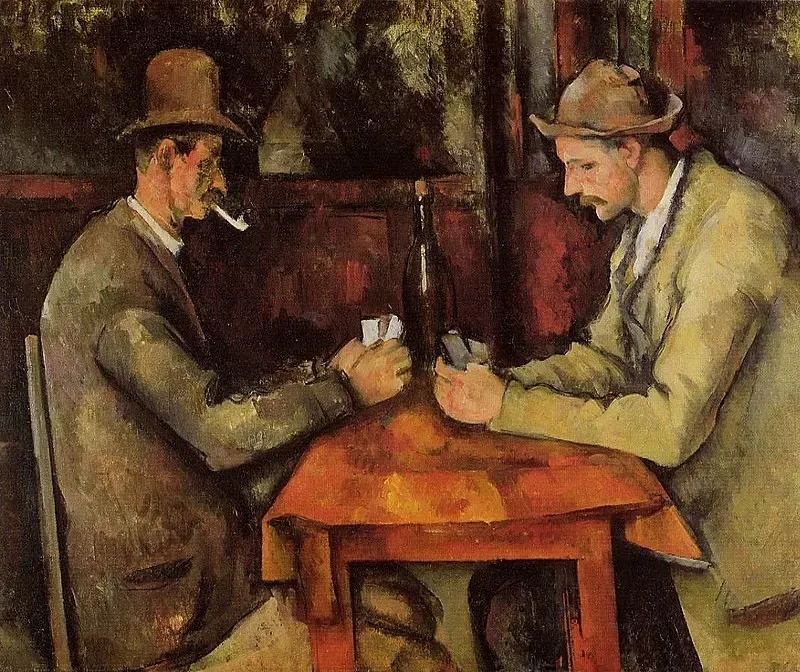
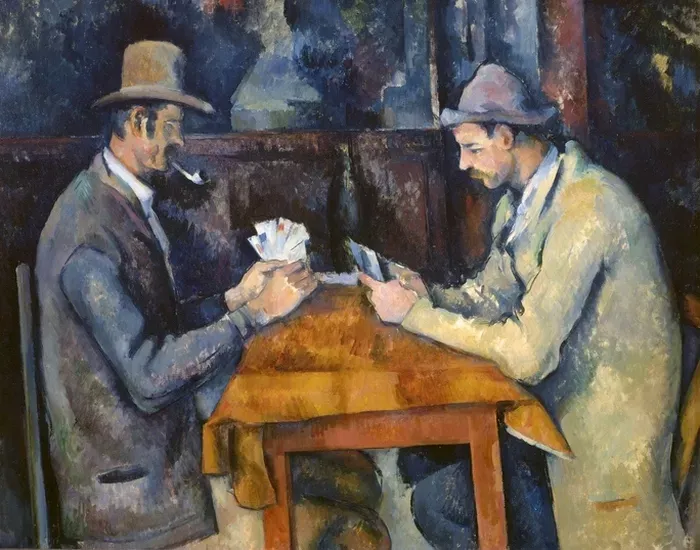
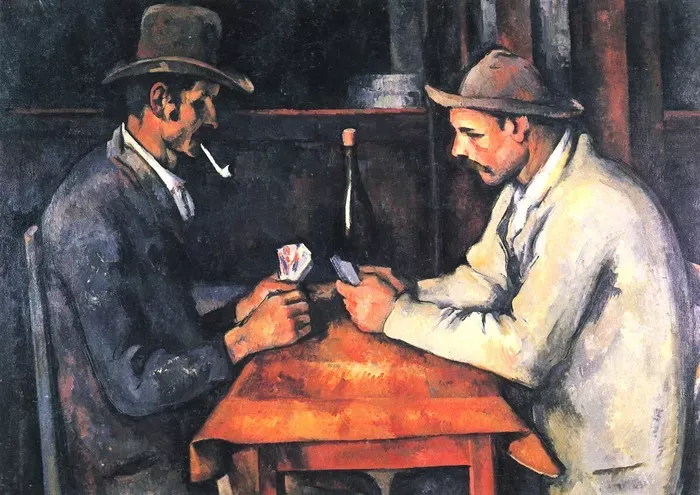
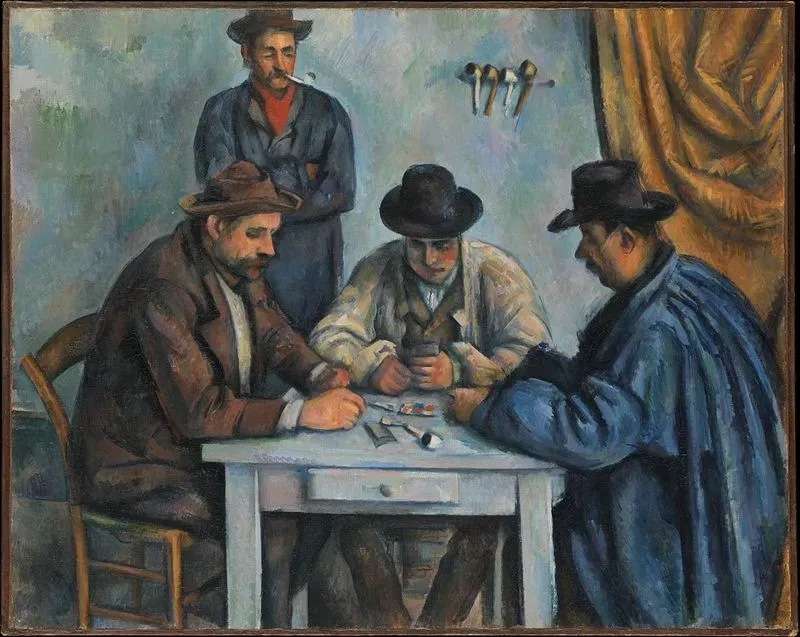
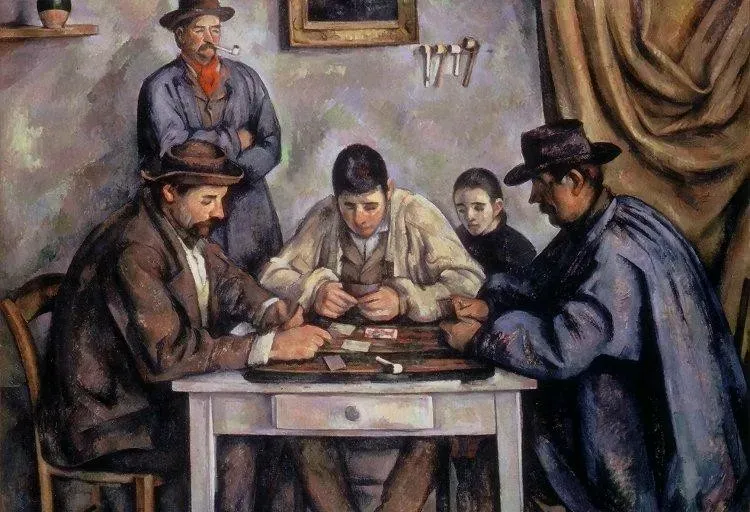
The local art museum was a source of inspiration. Cézanne attended an exhibition of the Le Nain brothers (artists of the first half of the 17th century) at the Aix-en-Provence Museum. One of their paintings happens to be called "Card Players."
It's believed that this inspiration could have been Cézanne's motivation for creating his own series with the same name.
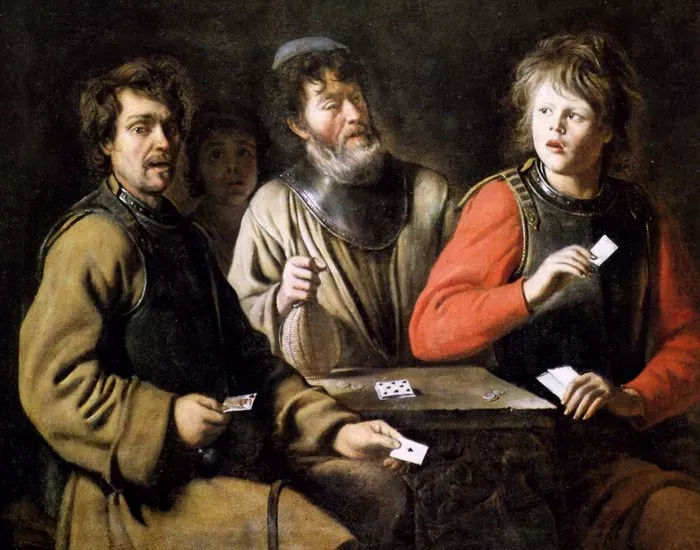
We don't have an exact chronology of Cézanne's Card Player paintings. For a long time, it was believed that Cézanne first painted a picture with five characters and completed the series with headshots, gradually reducing the sizes of the canvases. However, research using infrared scanning has cast doubt on this theory – it is quite possible that everything was the opposite.
The surrounding peasants served as Cézanne's models. These locals posed for Cézanne's paintings, some of whom worked on his estate, the Château de Bellevue. The man with the pipe was his gardener, and for additional posing work, he received five francs.
Cézanne prepared for a long time before painting commenced. It's no coincidence that Cézanne spent five years creating five paintings. He made over a dozen sketches during his preparation and painted several oil portraits. His patient models came again and again to pose for him.
Cézanne painted at a leisurely pace and he probably couldn't have created his most famous paintings if he had stayed in Paris. Local peasants, gardeners, and maids knew how to remain truly still and focused.
It doesn't appear the games were played for money. There is no trace of money or chips on any canvas. According to some experts, their absence indicates that people in the paintings play simply for pleasure, perhaps in gin rummy. Others believe that the artist left hints about the specific stakes in the game. If Cézanne painted "Card Players" today, perhaps he would have shown a couple of players multi-tabling online.
- Increased first deposit bonus
- Increased rakeback and reloads
- Help with deposits and cashouts
- Access to private freerolls
- Round-the-clock support
Cezanne's Characters Are Unlike Those Painted by Peers
For the first time in the history of known paintings, Cézanne's characters show emotional restraint during card games.
The artist depicted card playing not as a dynamic or anecdotal genre scene, as was typical for Dutch and French painting of the 17th century, but as a serious, clearly challenging, and somewhat monotonous task. Cézanne's players maintain poker faces, unlike the players of the Le Nain brothers or, for example, Caravaggio; there is nothing mischievous or humorous about those works. Although people are depicted in the painting, it sometimes seems more like a still life.
Where Are Cézanne's Card Players Now?
Sometimes, they are exhibited together, but the permanent exhibitions of each painting are at the Metropolitan Museum, New York; the Barnes Foundation, Philadelphia; the Courtauld Institute of Art, London; the Musée d'Orsay, Paris; and in the private collection of the Emir of Qatar.
One of Cézanne's oil paintings went on to sell for a record price – $250 million.
Unlike many of his artist friends who doubted the value of their own works, Cézanne clearly felt and sometimes proclaimed aloud that he was a genius and that his paintings would be understood many years after his death.
In 2011, the Qatari royal family bought one of the series from a Greek shipowner and collector for $250 million, marking the highest amount in the history of painting. The record was surpassed in 2015 by Paul Gauguin's painting "When Will You Marry?", which sold for $300 million.
Interestingly, Cézanne spoke very disapprovingly of Paul Gauguin, calling his works "painted Chinese pictures," considering his influence on the painting of other artists detrimental, and stating that Gauguin's painting was "nonsense" because "it lacks form."
Since 2017, the record belongs to Leonardo da Vinci – Christie's auction house sold "Salvator Mundi" for $450 million.
"Card Players" Stolen and Ransomed in Paris
In August 1961, a painting from the "Card Players" series exhibited in Paris fell into the hands of robbers. It became the most famous of the eight paintings by Cézanne stolen from a traveling exhibition in his hometown of Aix-en-Provence. According to newspaper reports, the paintings were stolen between dawn security shifts (or possibly while guards were dozing) at the Vendôme Pavilion, where the works were displayed. One of the thieves hid in the museum after closing, then let accomplices in through a second-floor window. They descended through the gates, leaving only a blurry trace on the windowsill. "It's the closest thing to a perfect crime I've ever seen," said one French detective. A ransom was paid for the paintings a few months later, after which they were returned.
To demonstrate the depth of the loss of national heritage after this theft, the French government issued a commemorative stamp.
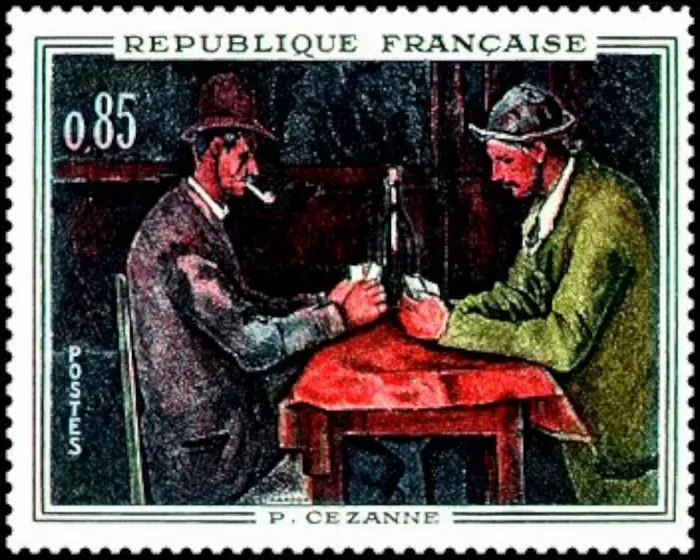
"Cézanne's Card Players" also heavily inspired the "Dogs Playing Poker" series, which many readers have seen. K. M. Kulich created a famous series called "Dogs Playing Poker." It's one of the most prolific series of paintings dedicated to poker, which we've written a guide to.
Quick Quiz on Cézanne's Works
In conclusion, try a few questions from the "What? Where? When?" database on the work of Paul Cézanne.
If you read our article carefully, answering some of them should be easy!
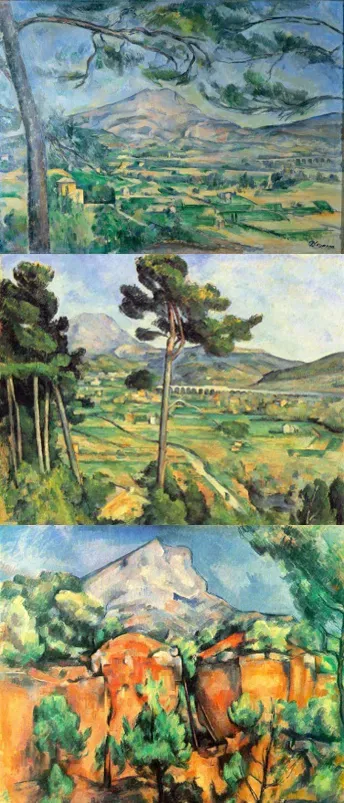
These paintings show styles that French master Alain Jaubert made statements about, which had a significant influence on Paul Cézanne's creativity. Who?
Answer: [Katsushika] Hokusai.
Comment: According to Jaubert, French artists of the 19th century, including Paul Cézanne, borrowed from Japanese ukiyo-e artist the principles of composition and the “serial nature” of drawings. The paintings show different views of Mount Saint-Victoire. Hokusai is famous for his series of prints "Thirty-Six Views of Mount Fuji".
Paul Cézanne often painted still lifes featuring fruits, like apples, pears, or oranges. He avoided dealing with peaches or, for example, apricots. Art historians explain this simply: some fruits suited Cézanne's working style more, others less so, as Cézanne worked... How? Answer in one word.
Answer: Slowly.
Comment: That’s why he didn’t depict perishable fruits. However, according to other sources, some apples still managed to spoil.
Sylvia Borghezi mentions HIM when talking about the focused figures in Paul Cézanne's painting "Card Players." Among Cézanne's paintings, there is "HE with Cupid." Name HIM.
Answer: Still life.
Comment: The players are depicted as motionless. In the painting “Still Life with Cupid”, the central place, surrounded by fruits, is occupied by a statuette of Cupid.
Lightning struck once a church in England, resulting in the deaths of four parishioners. It was rumored that the devil took the sinners because they were... WHAT? The royal family spent over 250 million dollars on "WHAT." Name it in two words.
Answer: Card players.
Comment: The royal family of Qatar purchased a Cezanne painting for a huge amount of money, from the series "Card Players."
Here's a description of Paul Cézanne's painting "Card Players": "The painting depicts a peculiar duel between two players. The absence of cups or glasses suggests that the game is taking place for a...". Complete this sentence with one word.
Answer: “...bottle.”
Comment: You can see a bottle right on the table!






